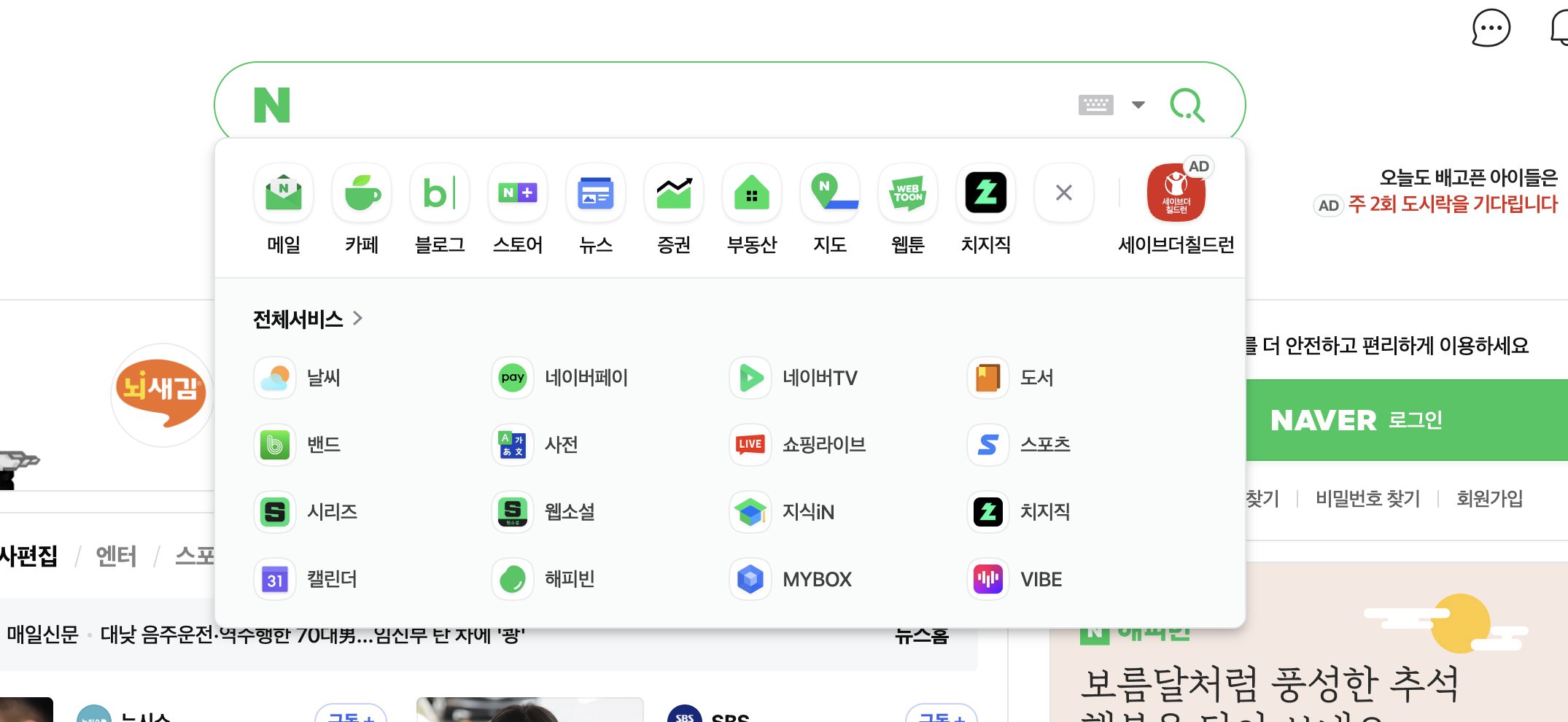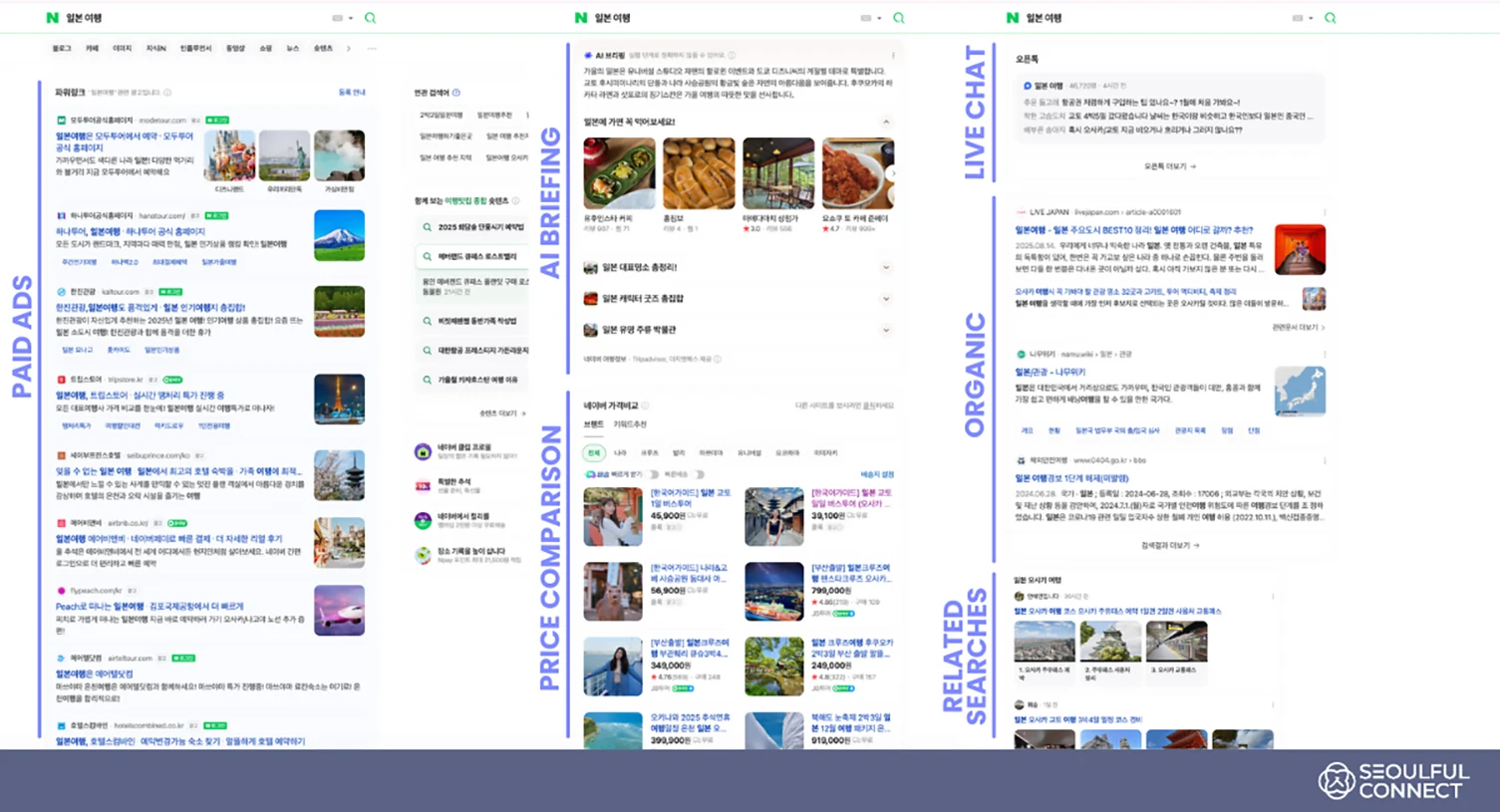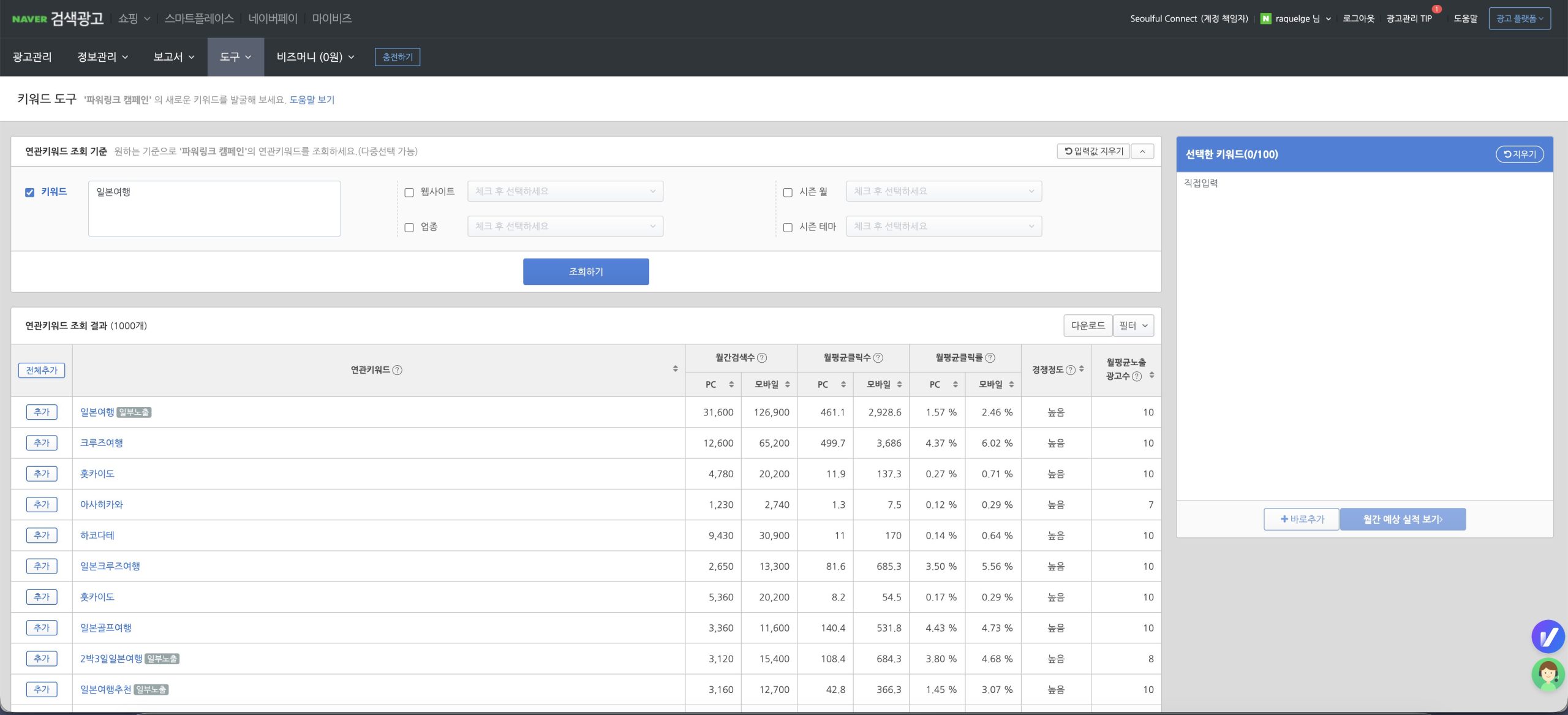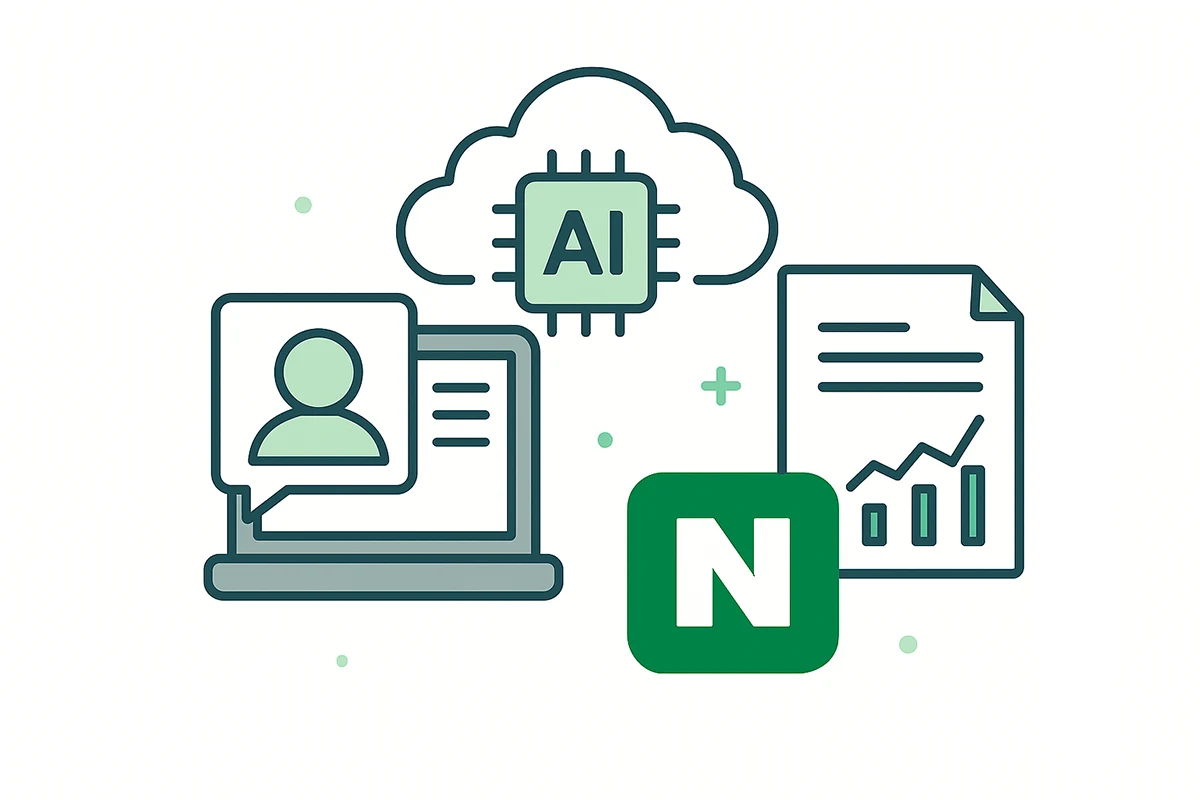

More and more companies are looking to expand into South Korea. The country has maintained steady economic growth in recent years and was ranked the sixth-largest economy in Asia in 2025. At the same time, Korea is gaining global recognition through its technological innovations and the rise of the K-wave, encompassing K-pop, dramas, fashion, beauty, and food.
However, entering Korea presents a unique challenge: Naver, the country’s dominant search platform ecosystem, operates very differently from Google.
In this article, we’ll explore the key differences between Naver and Google, and what you need to know before stepping into the Korean market.
In Korea, the search market is almost evenly split between Naver and Google. However, the reality is that performance often depends on the industry to which a website belongs. Some sectors find Naver to be the stronger channel, particularly for local and community-driven searches, while others see better results with Google.
This makes it clear that both platforms remain essential in Korea’s search landscape.
Naver’s strength lies in its ecosystem tailored for Korean users. Beyond search, it integrates services such as Naver Maps (and Kakao Maps) for highly accurate navigation, Naver Weather, which is updated with local data sources, and Naver Places, featuring detailed profiles of businesses and services nationwide.
This integration makes Naver especially valuable for users who rely on up-to-date, localized information. In many cases, Google’s capabilities are limited by Korea’s laws regarding access to geographic/mapping data.
Before diving into each detail, here’s a quick comparison of the main aspects that set the two platforms apart:
| Aspect | Naver | |
|---|---|---|
| Ecosystem | Prioritizes its own platforms (Blog, Café, Shopping, Places, etc.). Visibility often requires an active presence inside the Naver ecosystem. | Focuses on external websites and global standards. Rankings reflect authority across the open web. |
| Search results | Busy, portal-style SERPs with multiple verticals (blogs, cafés, shopping, news, video). Ads are heavy at the top (Power Links). AI Briefing is being tested to deliver short summaries alongside results. | Cleaner layout with up to 10 organic results. Ads usually appear as 1–3 slots per page. AI Overviews are integrated directly into SERPs, summarizing multiple sources. |
| Ranking factors | Emphasizes engagement metrics, social interactions on Naver platforms, and content freshness. | Emphasizes backlinks, technical SEO, and E-E-A-T (Experience, Expertise, Authoritativeness, Trustworthiness). |
| Content | Rewards fresh, frequent, Korean-language content. Prioritizes user-generated content (UGC) + KOL/influencer voices within its ecosystem. | Rewards high-quality, authoritative, and comprehensive content. External authority and E-E-A-T weigh more. |
| Keywords | Historically reliant on exact-match keywords. Now testing AI features that recommend related and trending queries, shifting toward topic clusters and intent. | Uses semantic search and intent by default. AI Overviews + AI Mode expand this by pulling from long-tail queries and related topics to generate summaries. |
| Technical | 아니요 hreflang support, but reads meta language tags. Site speed and mobile optimization matter. Limited structured data support. Best to submit a Korean sitemap. | Strong focus on hreflang, Core Web Vitals, crawlability, and rich structured data for enhanced results. |
| User behavior | Users rely on Naver for local services, real-time info, reviews, + community discussions. | Users turn to Google for global knowledge, research, + technical queries. |
In short, while both search engines share the same goal, the way they structure results, rank content, and integrate AI differs significantly. For businesses, this means you can’t simply copy-paste a Google SEO strategy into Naver.
Let’s break down each of these differences in more detail.
Naver is not just a search engine—it’s a portal, more similar to Yahoo (Japan) or Baidu (China) than to Google.
Users can do almost everything without leaving the platform: read news, check the stock market, look up words in its own Korean dictionary, pay with Naver Pay, watch Naver TV, read webtoons, send emails, and more.

At the core are services such as Naver Blog, Naver Café (community forums similar to Reddit), and Knowledge iN (a Q&A platform comparable to Google’s Quora).
These services dominate search visibility, meaning that to perform well on Naver, businesses often need an active presence within the Naver ecosystem, not just a standalone website. Content from external sites is much less likely to rank high compared to Naver-owned properties.
By contrast, Google’s ecosystem is open. Its results are primarily derived from external websites across the web, ranking them based on backlinks, authority, and relevance. Google doesn’t have built-in communities like Café or Blog, so it relies on independent publishers to provide content.
Finally, Naver also ties into other everyday Korean tools. For example, many users combine messenger platforms like KakaoTalk with Naver services. Bookings and payments often connect directly, making Naver feel like an essential part of daily online life in Korea.
Google and Naver may both be search engines, but their results pages look very different.
On Google, ads typically appear only at the top and bottom, leaving the middle space for organic results. But “organic” is also competitive:
In the example of “Japan trip”, you can see all these elements stacked, making it harder for websites to stand out.

On Naver, the page is much busier and ad-heavy.
In the example for “일본 여행 (Japan trip)”, you can see how little space is left for external websites—often just 2–4 organic slots buried far down.

You can search on Naver in other languages, but Korean queries return far more results and richer modules.
Naver uses its own algorithms focused on platform activity:
Naver also rewards interaction: comments, shares, engaged followers, and posts written from personal experience. In short, it values active creators and communities inside its ecosystem more than traditional authority signals.
Google, by contrast, is shaped by several well-known algorithms:
There are many more running in the background. Still, the key takeaway is that Google rewards content that best matches user intent and shows expertise, not necessarily the longest piece of content.
Naver rewards fresh and frequent content, especially when written in Korean. It heavily prioritizes user-generated content (UGC) + KOL/influencer voices published inside its own platforms like Naver Blog and Naver Café.
Posts that reflect personal experiences and attract engagement, such as comments, likes, and shares, tend to rank higher. For brands, this means maintaining an active blog presence on Naver can be just as important as having a website.
For example, if someone searches for “Japan trip”, a detailed blog post from a Korean traveler on Naver Blog may appear above a polished article from a global travel agency’s website.
Google, meanwhile, looks for high-quality, authoritative, and comprehensive content regardless of posting frequency. What matters is that the content:
For new websites or blogs, the strategies diverge sharply. On Google, it’s common to start by finding topic gaps competitors haven’t covered, so you can rank for niche queries and build authority step by step. On Naver, the recommendation is often to publish content daily for at least a month, signaling freshness and activity so the algorithm starts rewarding visibility.
In short, Naver favors fresh, community-driven voices, while Google prioritizes authoritative, expert-driven content.
Naver has historically relied on exact-match keywords, especially in titles and the first lines of content. Today, however, Naver is gradually shifting toward more semantic and intent-driven search.
With new AI features like “함께 많이 찾는” (Frequently searched together) + “함께 보면 좋은” (Good to view together), the platform now suggests related and trending queries, encouraging users to explore topic clusters instead of single terms.
For example, If someone searches for the stock TSLA, you can get recommendations about NVDA (엔비디아 주가) or AMZN (아마존 주식).
Google, in contrast, has long emphasized semantic search + query intent. Its algorithms are designed to interpret meaning, not just exact keywords.
With the rollout of AI Overviews + AI Mode, Google increasingly pulls in long-tail queries to generate summaries. This makes it more important to:
In short, Google prioritizes semantic relevance and topical authority, while Naver still leans on keyword precision but is moving toward cluster-based discovery with AI.
Tools for keyword research also differ: for Google, marketers rely on platforms like Google Keyword Planner, Ahrefs, or Semrush. For Naver, keyword research is typically done through Naver Keyword Planner (네이버 키워드 도구) inside Naver Ads or tools like Blackkiwi or Tisword.

Technical SEO matters on both Naver and Google, but each search engine evaluates it differently. Let’s take a look at some of the technical differences that exist:
Google supports hreflang tags, which are essential for multilingual and international SEO. They help the search engine deliver the right version of your page to users in different regions. Naver, however, does not support hreflang. Instead, it relies on meta language tags to identify the page language.
This means that for Naver, implementing hreflang is ineffective and optimizing content directly in Korean is the best approach.
On Google, site speed and mobile performance are critical ranking signals, especially since the introduction of Core Web Vitals and mobile-first indexing. Faster sites that provide smooth user experiences are rewarded.
Naver also considers speed and mobile responsiveness, but it tends to place less emphasis on them compared to Google. Still, a slow or poorly optimized site can negatively impact how Naver crawls and displays your content, so optimization should not be overlooked.
Both Google and Naver use structured data to better understand page content, but their support is very different in scope.
Naver recognizes schema.org markup in Microdata, RDFa, and JSON-LD formats, with JSON-LD and Microdata being the most recommended. It currently supports a limited set of schema types, including Organization/Person, JobPosting, Address, BreadcrumbList, FAQ, HowTo, ListItem (Carousel), AggregateRating, Recipe, Review, Restaurant, TVSeries, Movie, Software, and VideoObject.

Google, by contrast, supports a much broader range of structured data types. Beyond the basics, it uses markup for FAQPage, Event, Product, LocalBusiness, Article, Review, Recipe, Course, JobPosting, VideoObject, BreadcrumbList, and many more.
Structured data in Google is strongly tied to rich results like FAQ dropdowns, product carousels, recipe cards, and knowledge panels, making it a powerful tool to increase visibility directly in SERPs.
Google automatically discovers content across the web, but still benefits from submitting a sitemap via Search Console, which improves crawling efficiency and provides clear control on URL discovery.
Naver requires a more manual process. To appear in Naver search results, you need to submit your site through Naver Search Advisor and provide your sitemap (in Korean, if possible). This ensures Naver’s crawlers can collect and index your content properly.
Search behavior in Korea is shaped by strong preferences for community and local relevance. Many Koreans turn to Naver for everyday queries, especially when they want to read reviews, Q&A discussions, or blogs written by other users. It’s not just about finding information—it’s about seeing what other people think and share.
Google plays a different role. Koreans often use it for global information, technical searches, academic research, or English-language queries.
For example, a student might use Google to look up coding tutorials in English, while using Naver to check coffee shops reviews in Seoul.
Another important factor is trust in local services. Features like Naver Maps, Naver Places, and even KakaoTalk integrations make Naver feel more reliable for local, real-time needs. This is why user-generated content and local platforms dominate visibility there.
Koreans rely on Naver when they want local, real, and community-driven answers, and turn to Google when they need global, technical, or English-language information.
Both Google and Naver provide native tools to help you manage visibility, but they differ significantly in scope.
Google Search Console offers in-depth data on crawlability, indexing, Core Web Vitals, backlinks, and search queries. It’s a robust platform designed to give site owners full transparency over performance.
Naver Search Advisor, on the other hand, is much more limited. It allows you to submit sitemaps, request crawling, and check for errors, but it doesn’t provide the same level of keyword, performance, or backlink detail.
For marketers, this means optimizing for Naver requires not only using Search Advisor but also complementing it with external tools and active engagement inside the Naver ecosystem.
There’s a common misconception that expanding into Korea always means focusing exclusively on Naver. The truth is: it depends on your audience and your product.
For B2C products, Naver often dominates. Shopping results are heavily integrated, and Koreans like to read reviews before buying. For example, the keyword “사무용 책상 (office chair)” gets around 18K searches on Naver but only 200 on Google, showing why Naver is essential in this case.

For B2B services, Google tends to be the go-to platform. Potential buyers search in English or compare international providers. For instance, “클라우드 호스팅 (cloud hosting)” has around 30 searches on Naver but 200 on Google, showing where businesses should focus.
The key question is simple: where does your audience search? In many cases, the best strategy is to optimize for both, but always allocate resources based on audience behavior, not assumptions.
Takeaway: Naver isn’t always a must. Whether you should optimize depends on your industry, audience, + goals. For consumer products, Naver is often essential; for B2B and global services, Google may deliver more value. The smartest strategy is to go where your customers are searching.
Breaking into the Korean market means understanding that Google and Naver work very differently—from algorithms and content priorities to search results and technical requirements. Adapting your strategy to both is key if you want to succeed online.
At Seoulful Connect는, we specialize in Naver and Google SEO for the Korean market, helping international brands localize their presence, optimize for visibility, and grow with tailored international SEO strategies.


